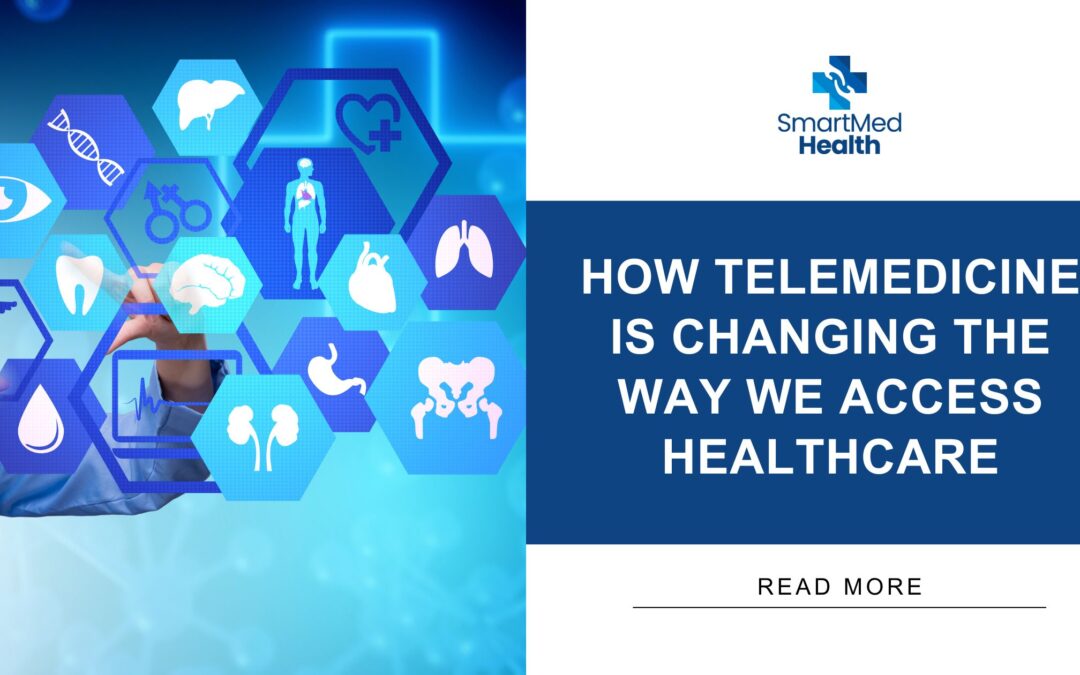- Telemedicine improves healthcare access by reducing barriers related to geography, cost, and convenience while supporting preventive care and early detection.
- Virtual platforms enhance mental health support, specialized care, and continuity of treatment through efficient communication and secure technology integration.
- SmartMed Health Walk-In Clinic and TeleHealth Services deliver both in-person and telemedicine care, ensuring patients receive accessible, high-quality healthcare tailored to their needs.
Access to healthcare has historically been defined by geography, schedules, and the availability of professionals. Appointments often required travel, time off work, and waiting rooms that were anything but comfortable. In recent years, telemedicine has introduced a significant shift in how patients and healthcare providers connect. What was once a supplementary tool has become a critical component of healthcare delivery, offering convenience, accessibility, and timely care that was previously out of reach for many people.
This transformation is not a trend with a limited lifespan. Telemedicine is reshaping the patient experience, influencing how hospitals, clinics, and doctors’ offices operate, and setting a foundation for the future of healthcare delivery worldwide. Understanding how telemedicine is changing access involves exploring not only the convenience it brings but also its broader impact on patient outcomes, equity, and the healthcare system as a whole.
Convenience Without Compromising Quality
One of the most significant contributions of telemedicine is its ability to provide convenience without reducing the quality of care. For decades, patients had to balance health needs with the logistical hurdles of scheduling, transportation, and long waits. Now, a virtual visit can often be arranged with a few clicks, allowing patients to see a physician from their home, office, or even while traveling.
Convenience is not limited to eliminating travel. Telemedicine appointments are often shorter and more efficient, with fewer delays compared to in-person visits. This streamlining does not mean that quality is sacrificed. In fact, many telehealth platforms are built with secure systems that integrate patient histories, lab results, and medication lists so physicians can make informed decisions quickly. The ability to prescribe medications electronically or refer patients for lab work adds another layer of continuity to care.
Expanding Access in Rural and Underserved Areas
Geography has long dictated the availability of medical services. Patients in rural communities often face challenges in finding specialists or even general practitioners. Traveling hours for a consultation can delay diagnosis and treatment. Telemedicine bridges this gap by allowing rural patients to connect with urban specialists or primary care providers without leaving their community.
This expansion of access has real-world outcomes. For instance, a rural patient with a heart condition can now consult with a cardiologist hundreds of miles away and receive the same standard of care as someone in a city. Remote monitoring tools further enhance this by enabling physicians to track vital signs and symptoms continuously. For underserved communities, where healthcare resources are limited, telemedicine reduces disparities and helps ensure that quality care is available to all, regardless of location.
Improving Continuity of Care
Healthcare is not about one appointment but rather a journey that requires consistent follow-up, monitoring, and communication. Continuity of care is essential for managing chronic conditions such as diabetes, hypertension, and asthma. Telemedicine strengthens this continuity by removing barriers to regular check-ins. Patients who might previously miss appointments due to transportation or time constraints are now more likely to engage with their care plans.
Virtual visits also encourage better communication between patients and providers. Secure messaging, video calls, and electronic health record integration create a seamless flow of information. Patients can quickly update their doctors about new symptoms, share test results, or ask questions, leading to earlier interventions and better outcomes. This ongoing communication builds trust and empowers patients to be active participants in their healthcare journey.
Mental Health Support Made More Accessible
Mental health has historically been under-prioritized in healthcare systems. Long wait times, social stigma, and limited access to trained professionals have made it challenging for many individuals to seek help. Telemedicine has created an avenue for mental health support that is private, immediate, and widely accessible.
Therapy sessions can be conducted from the safety of a patient’s home, which is particularly beneficial for those uncomfortable with in-person visits. Additionally, online platforms have expanded the availability of specialists who may not be present in every community. The rise of telepsychiatry and virtual counseling ensures that individuals dealing with anxiety, depression, trauma, or other mental health challenges can find professional help quickly.
Telemedicine has also proven useful in crisis intervention. Hotlines and video consultations connect patients with urgent support when needed, reducing risks and ensuring timely responses. The convenience of access encourages more people to seek and continue care, which is essential for lasting mental health improvement.
Cost Savings for Patients and Healthcare Systems
Financial barriers are one of the most common reasons people delay or avoid seeking medical care. Telemedicine contributes to reducing these barriers. For patients, virtual appointments often cost less than in-person visits, especially when factoring in travel expenses, lost wages due to time off work, and childcare costs.
For healthcare systems, telemedicine can reduce strain on emergency rooms and urgent care centers by providing alternative options for non-emergency situations. Hospitals can allocate resources more effectively when minor consultations are handled virtually. Preventive care through telemedicine also reduces costs in the long run by catching potential issues early before they develop into serious conditions requiring hospitalization.
This dual benefit of affordability and efficiency makes telemedicine a powerful tool for improving healthcare access on a large scale.
Enhancing Preventive Care and Early Detection
Preventive care is critical for maintaining overall health, yet it is often overlooked due to busy schedules or the inconvenience of frequent doctor visits. Telemedicine has simplified preventive care by making it easier for patients to schedule routine check-ups and screenings.
Virtual consultations allow healthcare providers to discuss lifestyle habits, track progress on health goals, and recommend preventive screenings based on individual risk factors. Remote diagnostic tools, such as wearable devices that monitor blood pressure or glucose levels, can alert providers to early signs of disease. This proactive approach supports early detection and better management of conditions, significantly improving long-term health outcomes.

Addressing Privacy and Security Concerns
A major consideration with telemedicine is the protection of sensitive patient information. Patients need assurance that their health records and conversations remain private. Telemedicine platforms use encryption, secure servers, and compliance with regulations such as HIPAA to safeguard patient data.
While security remains a challenge as technology advances, healthcare providers and telehealth companies continue to invest in stronger protocols. Patients are also being educated on how to protect their privacy, such as using secure internet connections and avoiding public Wi-Fi during consultations. By balancing accessibility with robust security, telemedicine maintains trust between patients and providers.
Integration of Technology and Healthcare
The success of telemedicine relies heavily on technology. High-quality video calls, wearable devices, mobile apps, and electronic health records work together to create a seamless care experience. These integrations allow physicians to access comprehensive data during virtual consultations, leading to better-informed decisions.
Wearables, such as smartwatches and medical-grade monitoring devices, allow patients to track vital signs and share real-time data with their providers. For example, a patient with atrial fibrillation can wear a device that alerts both the patient and the physician if irregular rhythms occur. This real-time data sharing supports more precise and timely interventions.
Technology is also enabling language translation services and accessibility tools that help break barriers for patients who speak different languages or live with disabilities. These innovations expand the reach of telemedicine and create a more inclusive healthcare system.
Telemedicine in Specialized Care
While telemedicine is widely associated with general consultations, its value extends to specialized fields as well. Dermatology, pediatrics, cardiology, and oncology are among the specialties that have embraced telehealth solutions. For example, dermatologists can evaluate skin conditions using high-resolution photos and video, providing timely diagnoses that prevent worsening.
In pediatrics, parents can consult doctors about their children’s symptoms without exposing them to unnecessary risks in crowded clinics. For cancer patients, virtual follow-ups reduce the burden of frequent hospital visits while ensuring consistent monitoring. Specialized telemedicine services expand the scope of care that patients can access without being limited by physical proximity to specialists.
Challenges and Limitations
While telemedicine has transformed healthcare access, it is not without challenges. Reliable internet connectivity is a barrier in many rural and low-income areas. Without stable connections, patients may face interruptions that affect the quality of consultations.
Another limitation is that not every medical issue can be resolved virtually. Physical examinations, diagnostic imaging, and surgical procedures require in-person visits. Telemedicine works best as a complement to traditional care rather than a complete replacement. Ensuring that patients and providers understand these limitations is essential for maintaining realistic expectations.
Additionally, healthcare providers must adapt to the new workflows that telemedicine requires. Training, technology adoption, and changes in insurance reimbursement policies are ongoing challenges that must be addressed to support long-term success.
The Future of Telemedicine
Telemedicine’s role in healthcare continues to expand, driven by technological advancements, policy changes, and patient demand. As artificial intelligence and machine learning integrate into telehealth platforms, providers will gain even more tools to support accurate diagnoses and personalized treatment plans.
Virtual reality and augmented reality may also find roles in telemedicine, enabling immersive training for healthcare professionals or interactive consultations for patients. The continued growth of remote monitoring devices will further bridge the gap between physical and virtual care, creating a healthcare system that is flexible, accessible, and centered on patient needs.
What remains clear is that telemedicine is redefining expectations around healthcare. Patients now anticipate convenience, immediacy, and personalized attention, and providers are adapting to meet these expectations. The future promises a more inclusive, efficient, and patient-centered healthcare system powered by telemedicine.
Conclusion
Telemedicine has created a fundamental shift in the way healthcare is delivered and accessed. It addresses challenges of geography, affordability, and accessibility while enhancing preventive care, continuity, and patient engagement. While challenges remain, the benefits of telemedicine are undeniable, and its role in healthcare will only continue to expand.
For patients, it represents empowerment and convenience. For providers, it represents innovation and efficiency. Together, these changes are paving the way for a healthier future.
Take control of your health with SmartMed Health Walk-In Clinic and TeleHealth Services. Whether you need in-person care or a virtual consultation, our team is ready to provide quality healthcare when you need it, wherever you are. Contact us today.


